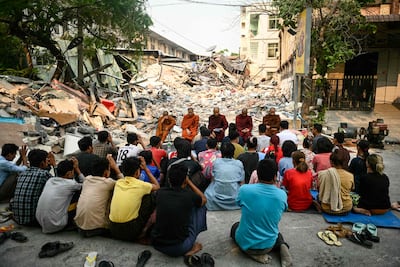Countries are drastically reducing foreign aid, the only difference among donors being the pace and extent of cuts.
For example, the US has suspended most of its foreign assistance that totalled $71.9 billion in 2023 – with all local workers and US diplomats reportedly to be fired from USAID, finalising the dismantling that began in February. France has reduced official development assistance (ODA) by $800 million, and the UK’s $20 billion aid pre-2023 halves by 2027. The Netherlands start retrenching in 2027, and cuts from Sweden and Germany are in motion.
The 1970 UN target dedicating 0.7 per cent of GNI to ODA is just a memory, having peaked at a mere 0.37 per cent in 2023. As the tectonic plates of foreign aid shift, what are the implications?
Disillusionment with aid was smouldering before US President Donald Trump returned to the White House. Toxic problems are not solvable through aid and create dependency among ill-governed receiving nations. Meanwhile, bloated aid agencies stand accused of resisting efficiency reforms.
In the “my country first” era, Mr Trump has made explicit what was earlier whispered: ODA is a tool to advance national interests, a byproduct being the relief of poverty and suffering, not the other way round.
The ungenerous world climate fuels those arguing that it is good if aid shortfalls force countries to spend more to care for their people. Why should others immunise or educate your children if your government will not uphold its own social contract with citizens?
Massive wealth creation has taken global GDP to a record $115 trillion. Although this is inequitably distributed, globalisation enables trickling down into nations. So many countries could afford financing more their own development. Why don’t they?
But enlightened aid recipients will take time to re-allocate domestic resources to serve their people, while callous or failed states will not even try. Thus, the consequences of sudden and drastic aid reductions are evident through increased hunger, disease, and suffering, such as with Rohingya refugees and Myanmar earthquake survivors, or Afghans and Gazans.

Thanks to media, such suffering is made visible and, by offending our sensibilities, drives more of the diminishing aid pot towards emergency relief.
But mounting crises – wars and climate breakdown – mean that humanitarian provision will never be sufficient. Not least as more is diverted towards increased refugee flows and disasters within donor countries. More aid rationing is inevitable and objective needs-based humanitarian allocations are jettisoned as donors decide who to help. For example, considerations of border security and migration loom large for Europeans and Americans.
This triggers the making of moral judgements over perceived faults and failures. Thus, Ukranians receive help as victims of Russian aggression, but Gazans are penalised because of Hamas presence within. The self-inflicted wounds of the Sudanese civil war receive less attention. Helping the affected in Jakarta’s flooding is unquestioned, but why rescue Haiti yet again after gangs destroyed its largest hospital refurbished with $30 million of American aid?
Of course, such differentiation victimises the innocent survivors of catastrophes. But that is dismissed as collateral damage in the Trump-inspired age of impatience that seeks easy solutions to complex problems.
As selectivity and fatigue replaces humanitarian universalism, development assistance is also squeezed. The massive $4.2 trillion annual gap for financing the failing Sustainable Development Goals (SDGs) could reach $7 trillion by 2030.
Looming over this is the greater – even existential – threat from reduced investment in “global public goods” (GPGs).
Public goods are products and services available at zero or negligible marginal cost to benefit everyone without disadvantaging any current or future consumers. The attributes of “pure” GPGs are, therefore: non-exclusion, non-rivalry, and sustainability.
Familiar examples are sunlight or a beautiful landscape, enjoyable by all equally and simultaneously. That contrasts with private goods. So, an open-access highway is a public good but tolls mean that only those who can afford them can travel.
Therefore, while it is laudable to strive for the 17 SDGs with 169 targets, they do not all qualify as GPGs. For example, it is desirable not to be poor and enjoy decent livelihoods, healthcare, education, safe water, and clean energy. But the benefits are individual, however positive the collective gain for populations.
But these excellent national goods do not qualify as GPGs because the delivering state does not offer simultaneous and equal benefits to other states. And, even within individual states, consumption is competitive because supply is not limitless while conventional markets do not work well for GPG provision.
The humanitarian domain also provides stark illustrations. Obviously, hunger and human rights abuses are outrageous but not GPGs. Because their correction mostly brings private benefits to the rescued, however decent it is to do so. In short, correcting egregious public wrongs do not automatically translate into collective public goods.
This debate is crucial for optimising foreign aid. When resources are limited, the correct moral recourse is their application towards doing the most good for most people at most times, without harming others. The concept remains valid even with aid driven by donor self-interest.
This implies shifting foreign assistance away from traditional development and humanitarian aid that bring private benefits towards building genuine GPGs. Three endeavours top the list.
First is climate change. But only “mitigation” through de-carbonisation qualifies as a GPG, and not "adaptation" which are humanitarian and development efforts to save lives and prevent individual or group disaster losses, important as they are.
Second is pandemic prevention through disease surveillance and protection. This is a GPG because “no one is safe until all are safe.” But vaccines and treatments qualify as GPG only when part of control strategies, and not for humanitarian reasons.
Third is preventing nuclear war as avoiding worldwide devastation is an obvious GPG. Stopping other conflicts is worthwhile but not a GPG because their terrible consequences are largely local or regional.
Re-casting aid necessitates restoring integrity in international financing starting with ODA as selfless aid provision without benefitting the donor. But GPG financing for climate, pandemics, and nuclear war prevention is self-serving because it benefits givers as much as recipients. Thus, the prevalent habit of placing GPG support under ODA requires correction through separation.
Meanwhile, shrinking ODA also requires prioritisation. The best way is to let countries achieve their own SDGs as best as their political will and resources permit. However, rich nations must not block poor ones from maximising and better utilising their own stretched funds.
First, by reducing indebtedness in the global south which expends more in loan repayments than on human development. Second, by tackling illicit financing flows that rob poor countries of billions of dollars. Third, by agreeing a fair corporate tax regimen for multinationals so that poor jurisdictions are not unduly exploited by profit-seekers. These are achievable measures for a fairer development financing system.
That would also allow shrinking donor government funds to focus solely on GPGs. Humanitarian relief may be left to the hearts and consciences of individuals, organised through civil society such as the Red Cross Red Crescent and NGOs. That would restore the eroded trust in humanitarian values by building essential people-to-people bridges in a way that cannot be done by geo-politically driven governments.
Getting better value from aid requires shifts from institutions deeply vested in current arrangements. It includes reforming the World Bank and drastically slimming or closing some UN agencies. As well as focusing diplomatic energy on useful fora only, such as the climate-related Conferences of Parties, World Health Assembly and the UN disarmament machinery. That is more productive than the endless venting of frustrations at the toothless Human Rights Council or on unlikely Security Council reform.
Most recognise the necessity for improving aid effectiveness and will eventually be obliged to get behind required changes. However the bigger challenge is on achieving consensus for a meaningful re-envisioning of aid that restores its moral purpose.


